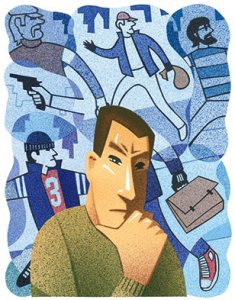
Crime Seen
The testimony of criminal witnesses can be notoriously flawed. But is there more to the problem than meets the eye?
By Virginia Wright
Gina Petracca ’10 finds Graham Pearson ’10 waiting when she enters a psychology laboratory in Pettengill Hall. Pearson has just watched a short video of a mock bank robbery, a key tool in Associate Professor of Psychology Amy Bradfield Douglass’ latest study into the reliability of eyewitness testimony.
Petracca sits down across from Pearson — who knows only that he’s going to be asked about what he’s witnessed — and begins reading questions from a clipboard.
“What was the color of the hat worn by the robber?”
“White,” Pearson responds.
“How confident are you in the answer you gave?”
“I think I’m 95 percent sure.”
Petracca notes the responses and continues questioning Pearson about the robber’s jacket, his eye and hair color, and where customers were standing, asking him to rate his confidence each time. Eight questions in, Petracca flips through her notes and casually remarks, “Compared to most people, you seem to have a pretty good memory for crime scenes.” Pearson smiles broadly. “Yes!” he exclaims, giving a brief fist pump.
The questioning resumes.
What Pearson doesn’t know is that Petracca’s compliment was scripted and completely unrelated to his answers. In fact, had she picked up a different questionnaire from Amy Douglass, the sheet may have cued her to remark on Pearson’s weak memory. Or she may have said nothing at all to him.
“We’re trying to understand how feedback changes what [eyewitnesses] choose to report.”
By the end of the winter semester, Douglass will begin to analyze data from 150 unwitting mock eyewitnesses like Pearson to determine how a crime investigator’s feedback affects testimony. “What happens to an eyewitness’ recall when you say, ‘You’re doing a really good job’?” explains Douglass. “The witness may think, ‘I have a good memory — they told me so — so I’m going to tell them everything I can because it must be right.’ We’re trying to understand how feedback changes what they choose to report.”
The study is part of a three-year research project, supported by a $129,000 National Science Foundation Grant, that will delve into the investigator-eyewitness relationship. Future phases could find Bates students working as lab assistants in Australia with Douglass’ colleagues, Neil Brewer, a professor of psychology at Flinders University, and Carolyn Semmler, a lecturer in psychology at University of Adelaide.
Psychologists have long warned about the fallibility of eyewitness identification procedures, and anyone who’s seen My Cousin Vinny, a perennial favorite among criminal defense lawyers, understands the pitfalls of eyewitness testimony.
“There is little relationship between confidence and accuracy. You can have a confident, compelling witness who is wrong.”
But in recent years, DNA testing and memory research have brought renewed scrutiny. Particularly alarming is a study published last year by Gary Wells, perhaps the country’s best-known figure in eyewitness research. Wells reported that faulty eyewitness testimony played a key role in the convictions of 230 men who were later exonerated by DNA testing. The most tragic of these cases was that of Timothy Cole, who died in prison 13 years after being falsely convicted of rape.
The disconnect between truth and justice only widens when criminal cases go to trial. “Jurors give much weight to the testimony of eyewitnesses who seem confident,” Douglass says. “Yet there is little relationship between confidence and accuracy. You can have a confident, compelling witness who is wrong.”
Douglass’ interest in the intersection of psychology and the law was sparked when she was a junior at Williams College. “I had no idea the discipline existed,” she says, “until I took a class taught by Saul Kassin,” an expert in false confessions in criminal cases. “The topics we covered were so fascinating and so important to how we convict people.”
She ditched her plan to pursue clinical psychology and instead did graduate research with Wells at Iowa State University. Their co-authored 1998 study, published in the Journal of Applied Psychology and highly publicized in the mainstream media, dramatically demonstrated the ease with which eyewitnesses are swayed by crime investigators’ responses to their accounts.
Among their findings: Mock eyewitnesses who were initially tentative about what they’d seen on a security camera video became far more certain about all aspects of their testimony after they’d been congratulated for identifying the suspect (when, unbeknownst to them, the suspect was not in the photo lineup at all).
“One simple comment from the investigator easily distorted their judgment,” Douglass said. As Wells told The New York Times in 2000, the “conjunction” of eyewitness unreliability and the persuasiveness of eyewitness testimony “should concern us.”
While Douglass’ current research is similar to her work with Wells in the 1990s, she’s trying to delve more deeply into the eyewitness-investigator relationship and, ultimately, to help police collect better information from their eyewitnesses.
During the Bates experiments, interviewers like Gina Petracca act as “confederates” — trained to give certain kinds of feedback without the witnesses’ knowledge. In another phase of the ongoing experiment, the eyewitnesses will be confederates who offer either highly detailed or very broad recollections. “We want to know if investigators’ questions change” — depending on what they hear — “and what conclusions they draw about the witnesses’ accuracy,” Douglass explains.
There will be no confederates in the third phase, but participants will be given goals that may conflict. An eyewitness told to report only broad strokes may be interviewed by an investigator told to seek much detail, for example. The researchers will analyze how the participants negotiate those differences and how it affects the results.
Douglass’ current collaboration with Australian researchers Neil Brewer and Carolyn Semmler reflects a growing professional relationship. In 2007, aware of Brewer’s work since her Iowa days with Wells, she invited him to present at the Society for Applied Research in Memory and Cognition’s biennial conference, hosted by Bates. The next year she received a Bates Phillips Faculty Fellowship to work in Brewer’s lab for three months.
“Research is truly international,” says Brewer. “Without funding from our institutions so she could come here in 2008, this particular project would never have happened.”
Back in the psych lab, Graham Pearson, a history major from Irvington, N.Y., who rows for the varsity crew, merely grins when Douglass assistant Kate Reilly ’10 reveals the charade. She and Douglass quiz him for a few minutes, asking if he had any suspicions about Petracca’s comments (he didn’t). Pearson leaves with a little extra cash in his pocket and self-esteem solidly intact.
The result satisfies Douglass. “It’s important that subjects understand why the deception was necessary and that they don’t feel bad about being deceived,” she says. “We want them to feel as good leaving as they did when they came in.”
Virginia Wright profiled Lewiston filmmaker and activist Craig Saddlemire ’05 in the Fall 2009 issue.



